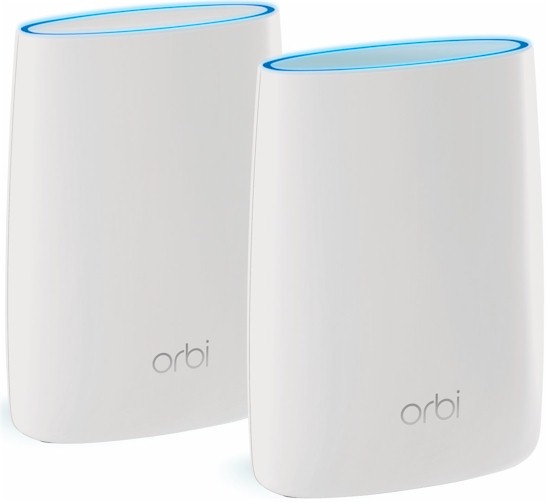
| At a glance | |
|---|---|
| Product | NETGEAR Orbi Wi-Fi System AC3000 (RBK50) [Website] |
| Summary | Extender type three-radio Wi-Fi System with dual-band two-stream AC client and four-stream dedicated 5 GHz backhaul radios Four port Gigabit Ethernet switches on both base and satellite units. |
| Pros | • Best performance of any multi-unit / mesh system. • Base unit is a full-featured AC1200 class router • MU-MIMO supported for both client and backhaul |
| Cons | • Nothing significant |
Typical Price: $151 Buy From Amazon

| At a glance | |
|---|---|
| Product | Linksys Velop Tri-band Whole Home Mesh Wi-Fi (WHW0303) [Website] |
| Summary | 2×2 “mesh” tri-radio router with two 5 GHz and ZigBee radios. |
| Pros | • Two 5 GHz radios for more connection options • Decent routing feature set • Works if internet connection goes down |
| Cons | • ZigBee radio not enabled |
Typical Price: $299 Buy From Amazon
Introduction
Updated 1/30/18 – Corrected 2.4 GHz Rvr plots
I’ve been reluctant to award a SmallNetBuilder Top-Ranked award to a Wi-Fi System until I had a chance to retest NETGEAR’s original "AC3000" Orbi (RBK50) and Linksys’ Velop. I declared Orbi the Wi-Fi System to beat when it was tested almost a year ago now, but was disappointed by Velop when it was tested a few months later. Even with its second 5 GHz radio, Velop’s poor backhaul bandwidth made it an also-ran.
But now that the original Orbi and Velop have both been retested with our new more comprehensive Revision 1 Wi-Fi System process, it’s time to formally declare NETGEAR’s original "AC3000" Orbi as the winner of our Top Ranked Performance award for Wi-Fi Systems.
I’ll let the test results speak for themselves. All tests were done with V1.12.0.18 firmware for Orbi and 1.1.2.181801 for Velop.
Inside
First, a short detour to list Orbi and Velop’s innards. The table also includes Orbi mini components, which were not included in the Wi-Fi System Roundup. The Orbi components are for the desktop version; I didn’t open up the wall-plugged Orbi mini satellite. The mini is built from essentially the same components as Orbi original. The main changes are a QCA 9886 2×2 5 GHz radio for backhaul and the use of Quorvo QPR4518 5 GHz front ends vs. RFMD 5 GHz power amplifiers.
| NETGEAR Orbi RBK50 | NETGEAR Orbi RBK40/30 | Linksys Velop | |
|---|---|---|---|
| CPU | Qualcomm IPQ4019 quad-core Wave2 2×2 a/b/g/n/ac SoC | Qualcomm IPQ4019 | Qualcomm IPQ4019 |
| Switch | QCA8075 | QCA8075 | QCA8072 |
| RAM | 512 MB | 512 MB | 512 MB |
| Flash | 4 GB | 4 GB | 4 GB |
| 2.4 GHz Radio | – In IPQ4019 – Skyworks SKY2623L 2.4 GHz Power Amp (x2) |
– In IPQ4019 – Skyworks SKY2623L 2.4 GHz Power Amp (x2) |
– In IPQ4019 – MSC5533621E (maker unknown) 2.4 GHz power amp (x2) |
| 5 GHz radio | – In IPQ4019 – RFMD RFPA5542 5 GHz power amp (x2) |
– In IPQ4019 – Quorvo QPF4518 5 GHz front end (x2) |
– In IPQ4019 – Skyworks SKY85408-11 5 GHz Power Amp (x2) |
| 5 GHz backhaul | – QCA9984 – RFMD RFPA5542 5 GHz power amp (x4) |
– QCA9886 2×2 5 GHz a/n/ac SoC – Quorvo QPF4518 5 GHz front end (x2) |
– QCA9886 2×2 5 GHz a/n/ac SoC – Skyworks SKY85408-11 5 GHz Power Amp (x2) |
| Bluetooth | CSR8811 Bluetooth 4.1 SoC | CSR8811 Bluetooth 4.1 SoC | CSR (part # ?) |
| IoT | None | None | – Silicon Labs EM3581 ZigBee / Thread SoC – SiGe 2432L 2.4 GHz ZigBee front end |
Table 1: Component summary and comparison
Routing Performance
NETGEAR’s mini Orbis (RBK30/40) were fine on downlink, but ran about half as fast on uplink. Original Orbi was half again slower than the minis on down, but about the same running uplink. This is in the default configuration and I didn’t explore the reasons for the relative slowness.
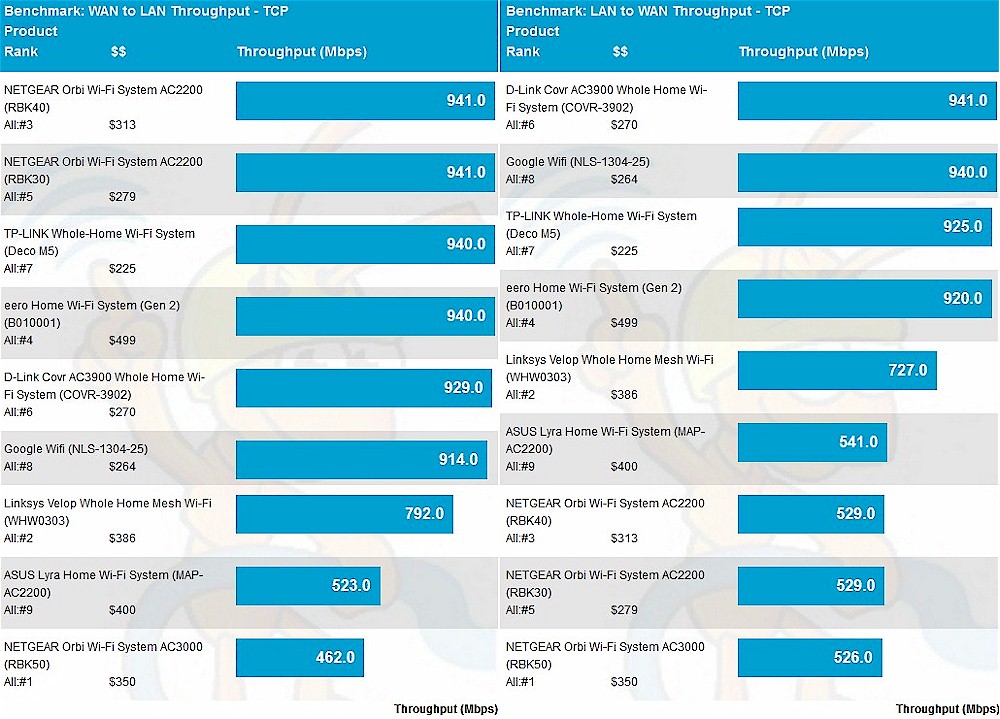
Routing throughput – iperf3 method
The HTTP test method is better at showing performance differences under load, downloading four different size image files with 2K concurrent connections. The plot below compares mini and original Orbi and Velop.
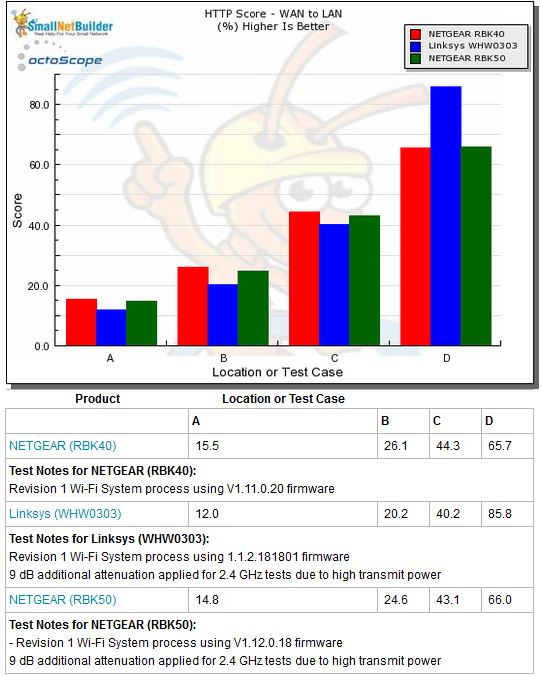
Routing throughput – HTTP Score comparison – WAN to LAN
Plot key file size: [A] 2 KB, [B] 10 KB, [C] 108 KB and [D] 759 KB file
The two Orbis track pretty well. So I’m at a loss to explain the difference on the simpler iperf3 test.
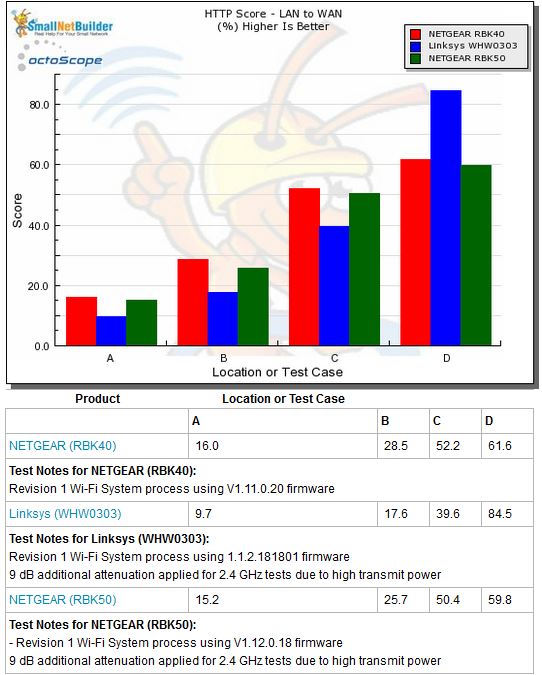
Routing throughput – HTTP Score comparison – LAN to WAN
Wi-Fi Performance
Here’s what Velop looked like in the octoBox 18" test chamber…
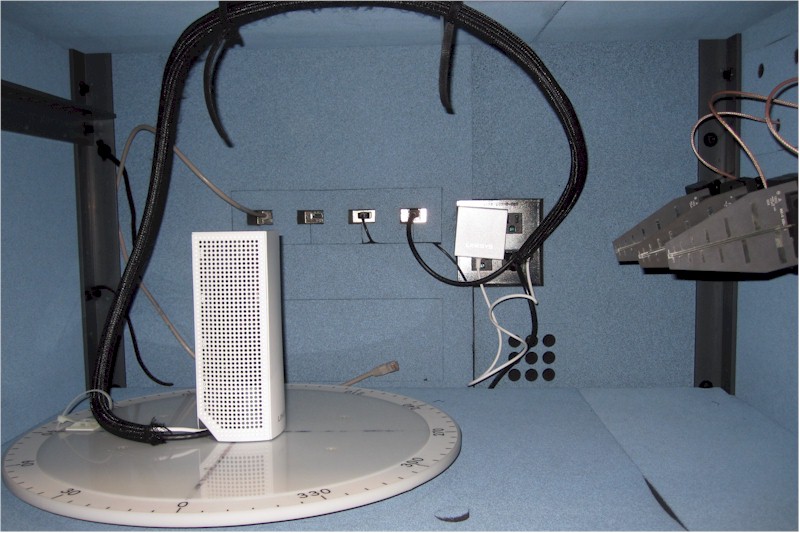
Linksys Velop in test chamber
… and big Orbi. I’m glad it’s not taller; it just about touched the top of the chamber.
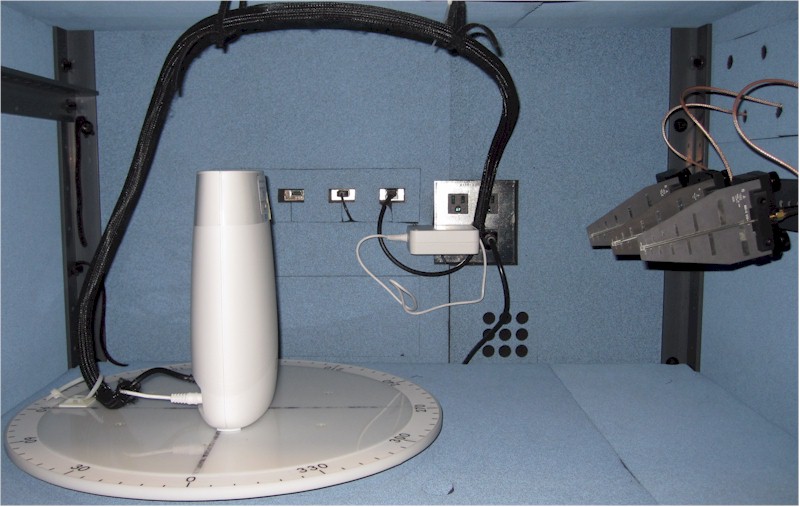
NETGEAR Orbi in test chamber
Throughput vs. Attenuation (RvR)
Updated 1/30/18
The Rate vs. Range or RvR benchmarks look at how throughput varies with decreasing signal. This test is done on the root node, so is a best-case view and does not include any effects from backhaul links.
Both Orbi and Velop ran a bit "hot" on 2.4 GHz downlink, exceeding the octoScope Pal reference client’s -30 dBm maximum recommended input level. Instead of manually inserting additional attenuation, I shifted both plots by 9 dB. So the first point plotted was actually measured with 9 dB of attenuation set. The 2.4 GHz downlink plot shows both products tracking pretty closely, with a slight advantage for Velop.
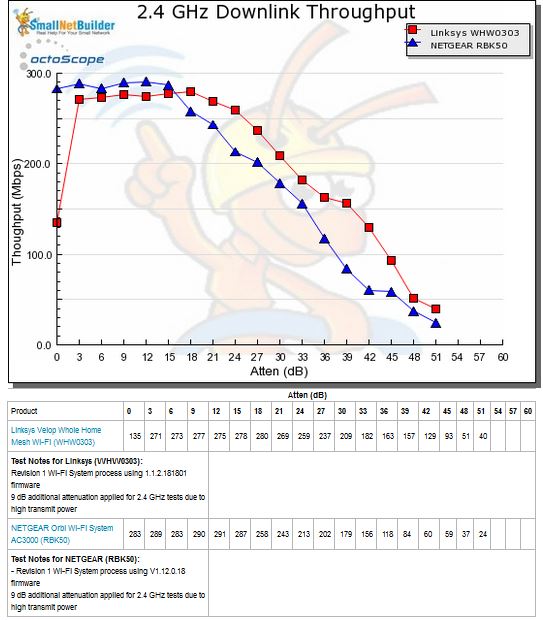
Throughput vs. Attenuation – 2.4 GHz downlink
2.4 GHz uplink results are also shifted 9 dB and again track pretty closely.
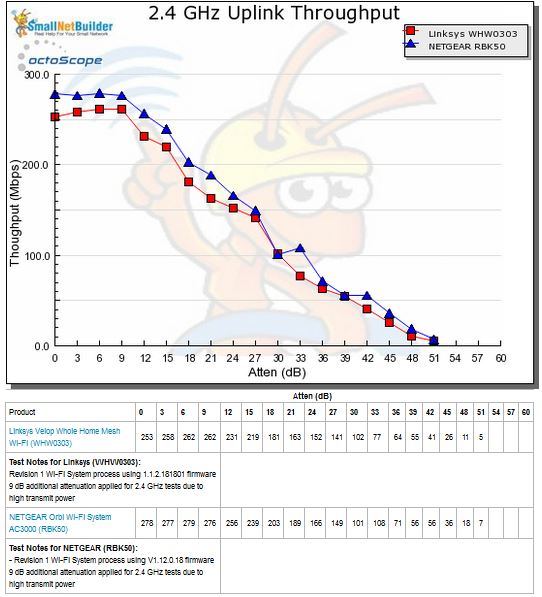
Throughput vs. Attenuation – 2.4 GHz uplink
5 GHz downlink results are also pretty close…
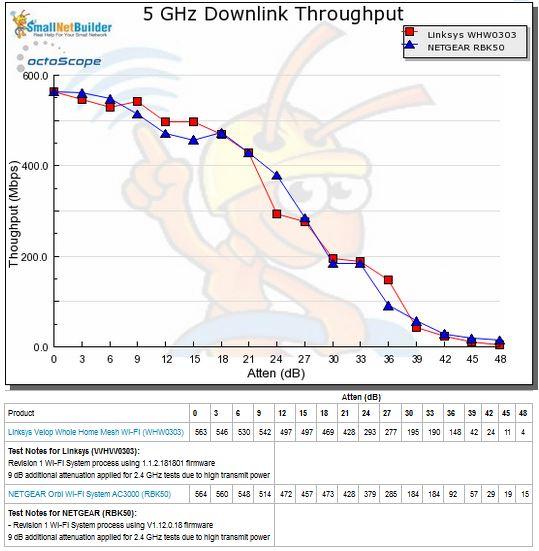
Throughput vs. Attenuation – 5 GHz downlink
… as are 5 GHz uplink. Neither of these plots are shfited.
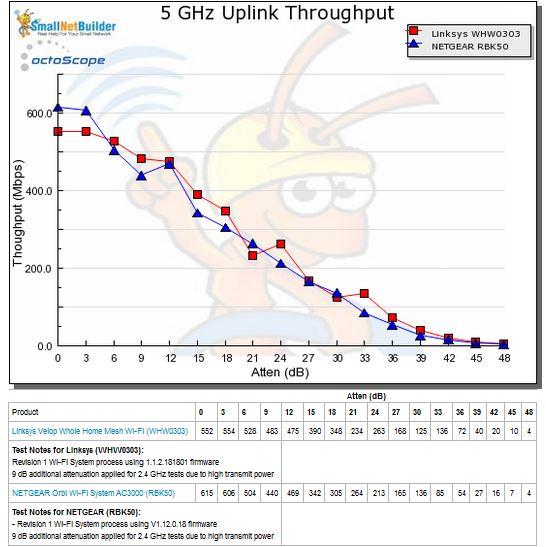
Throughput vs. Attenuation – 5 GHz uplink
The upshot of all this is both Orbi and Velop should have similar range for connected clients.
Wi-Fi System
These benchmarks measure up and downlink 2.4 and 5 GHz throughput at each system node, providing a good indication of what’s happening in the backhaul in each node. Since tests are made with 0 dB attenuation between the Pal test client and each system node, all measurements are best case. As signal levels between system node and client drop (i.e. distance increases), throughput will decrease proportionate to the RvR curves above.
The 2.4 GHz downlink chart shows throughput measured at each node, with the A bars being the root node and B bars the Hop 1 node. For Orbi, the C bars represent Hop 1 (the lone Satellite) with 21 dB of attenuation set between client and Satellite. For Velop, which has three nodes, the C bars show Hop 2 throughput. Keep in mind 2.4 GHz tests are made with 9 dB of attenuation between node and octoPal client vs. the 0 dB normally used. 5 GHz measurements are done with 0 dB.
Orbi shows essentially the same throughput for all three cases; the 21 dB of attenuation still puts throughput on the flat part of the RvR curve shown above. But what’s going on with Velop for Case C?
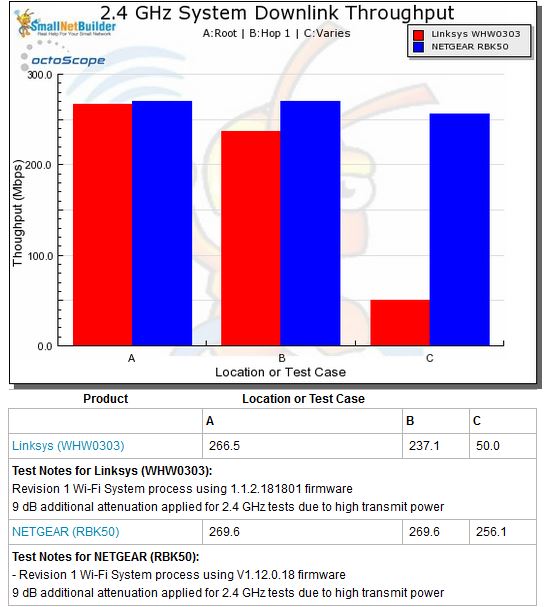
Wi-Fi System Performance – 2.4 GHz downlink
A check of the Pal station statistics revealed an interesting finding; each node was operating on a different 2.4 GHz channel! For this test, the Root node was operating in 40 MHz bandwidth on channels 4 and 6, Hop 1 was on Channel 7 also running 40 MHz bandwidth and Hop 2 was running on Channel 1, but in 20 MHz bandwidth! Mystery solved!
2.4 GHz uplink shows a similar pattern, i.e. steady throughput with Orbi and declining throughput with Velop.
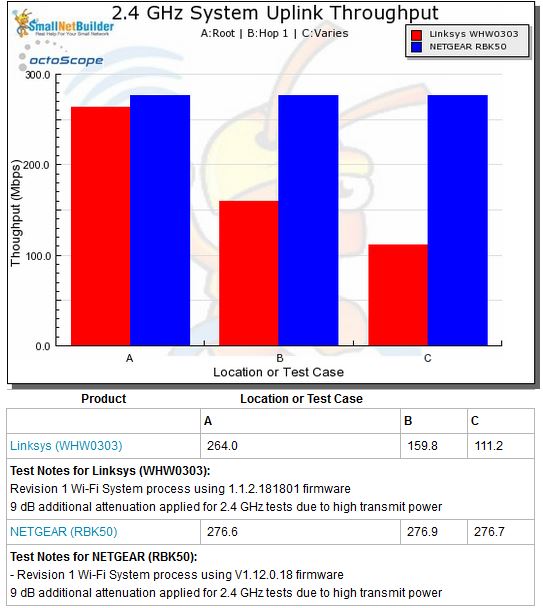
Wi-Fi System Performance – 2.4 GHz uplink
5 GHz downlink finally shows lower Orbi throughput in Case C with 21 dB of attenuation between Satellite and Pal client. Velop throughput is also lower, much lower, even with two 5 GHz radios to choose from. I should note Root and Hop 2 throughput were both measured on Channel 149, but Hop 1 was measured on Channel 36. So it doesn’t appear that Velop uses a dedicated 5 GHz channel for backhaul.
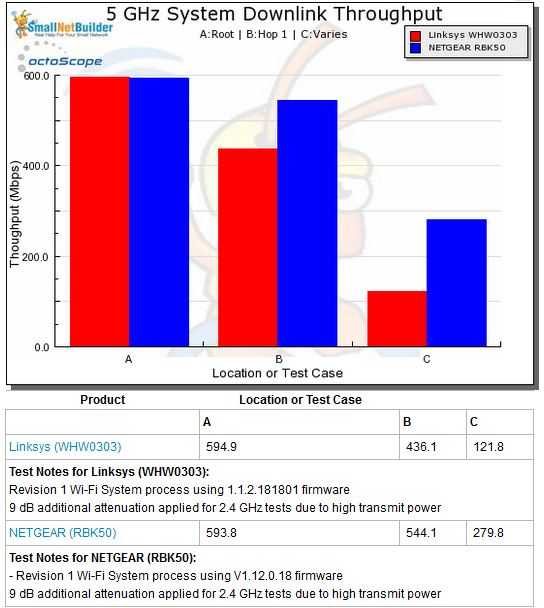
Wi-Fi System Performance – 5 GHz downlink
5 GHz uplink also shows lower throughput across all nodes for both Orbi and Velop. But Velop again takes a larger hit than Orbi on the second Hop (Case C).
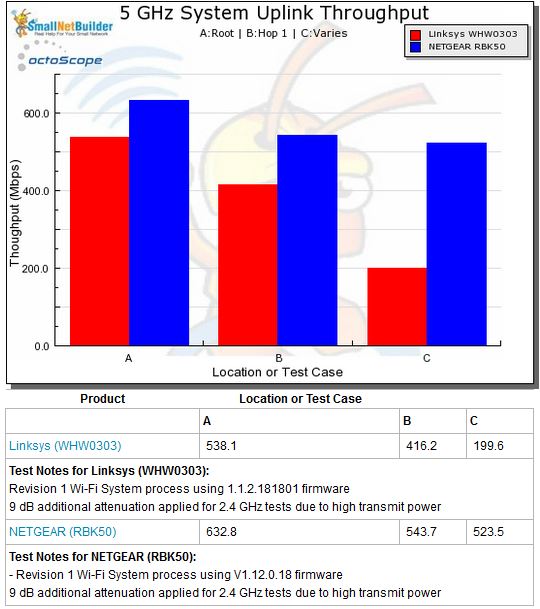
Wi-Fi System Performance – 5 GHz uplink
Backhaul
So let’s look at backhaul performance to see if it offers any clues for Velop’s falloff on the second hop. I limited the plot below to Orbi, Orbi mini and Velop to keep things focused. Remember this is measured from the root node Ethernet port to the Ethernet port on the specified Hop. First observation is how close Velop and Orbi mini’s 2×2 backhaul comes to original Orbi’s 4×4. I would have expected higher throughput from 4×4 Orbi.
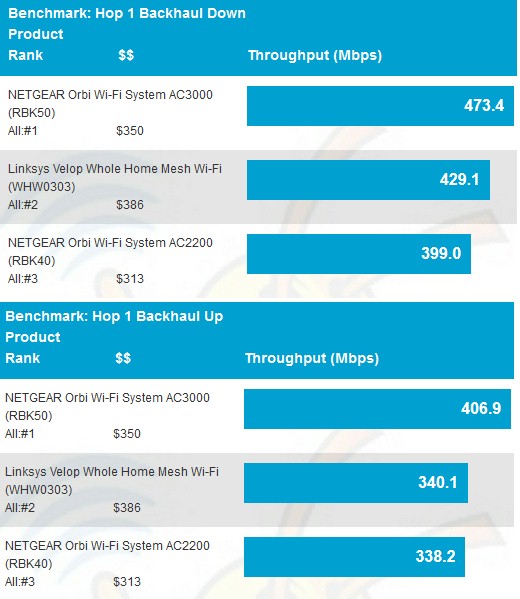
Wi-Fi System Backhaul – Hop 1
These results are lower than the over-the-air backhaul testing I did in the original Orbi review. In my "Living Room" location, I measured 528 Mbps downlink and 414 Mbps up.
Orbi can’t support two hops, so I’ll show just show Velop and the other products that can. Velop clearly beats the pants off eero Gen 2, the only other of the products shown below that has a second 2×2 5 GHz radio.
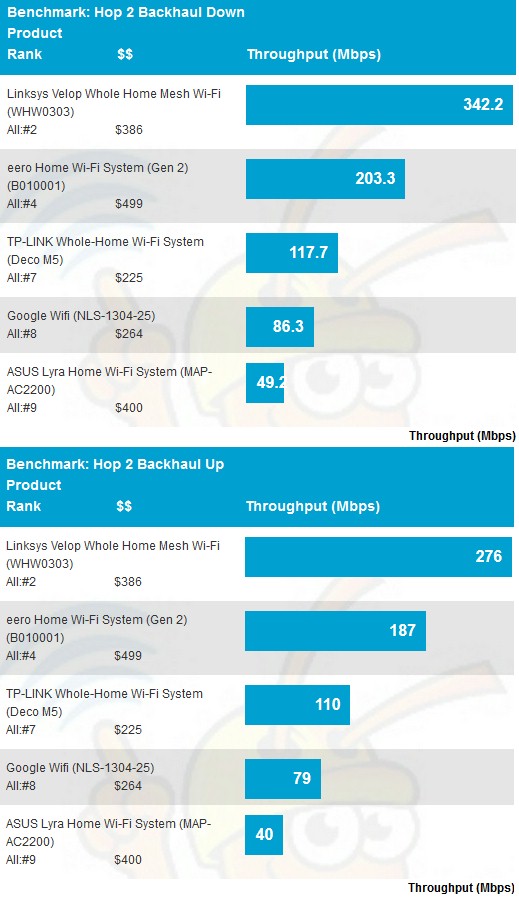
Wi-Fi System Backhaul – Hop 2
Capacity
Our Wi-Fi System capacity test uses three 2×2 AC clients, one connected to each node of three node systems. Traffic is then run to all three clients simultaneously and throughput measured for each traffic pair. A 2.4 GHz client is connected to the root node and 5 GHz to the others. The Capacity bar chart shows total throughput for the three test clients in each direction.
Original Orbi is clearly the winner here for both down and uplink. But while Velop is in the #2 slot for uplink, it sits below all the Orbis and D-Link’s Covr (review coming next).
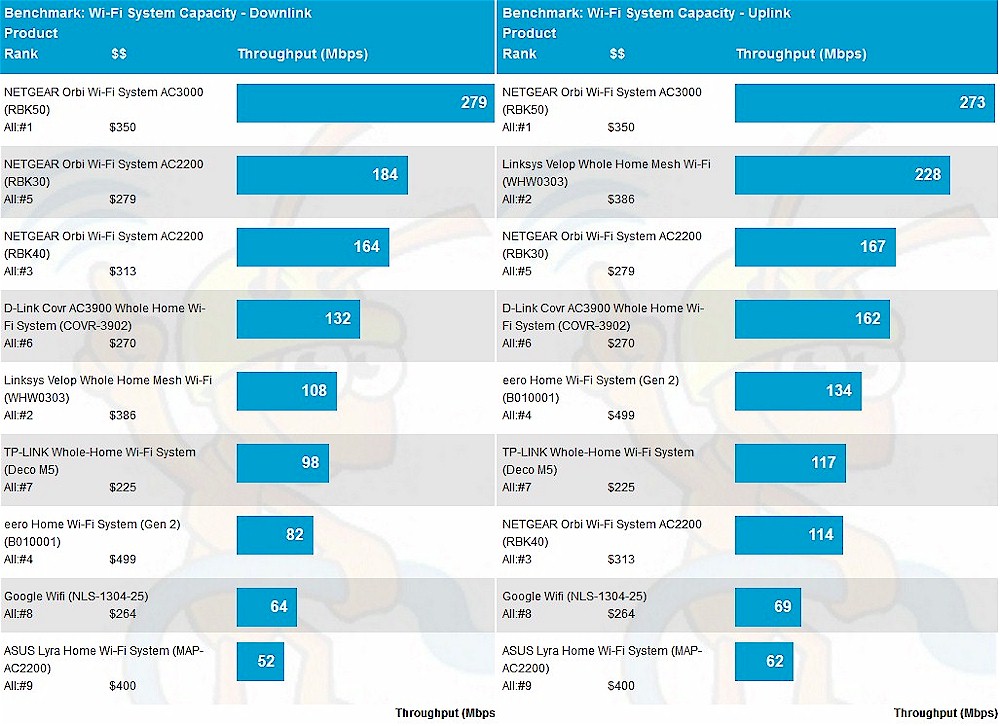
Wi-Fi System Capacity
The per-node plots show Velop takes a severe throughput hit when both leaf nodes (Hop 1 and 2) are loaded with 5 GHz traffic. Keep in mind that since Orbi has no second hop, both 5 GHz clients are banging away on the same satellite.
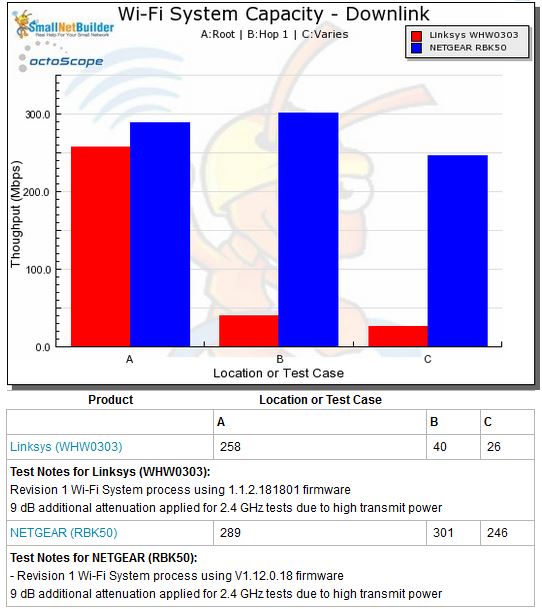
Wi-Fi System Capacity by Test Case – downlink
I sure didn’t expect the results in the uplink plot; Velop’s Hop 1 throughput jumps from 40 to over 300 Mbps!
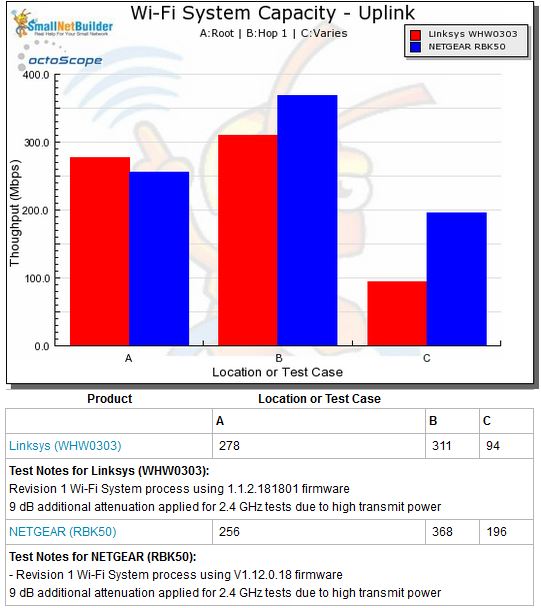
Wi-Fi System Capacity by Test Case – uplink
Going to Velop’s capacity test downlink time plot, it’s clear Hop 1 is low throughout the test, but has some cyclical variation. Station statistics, however, show both up and down link rates steady at 866 Mbps (2×2 11ac maximum).
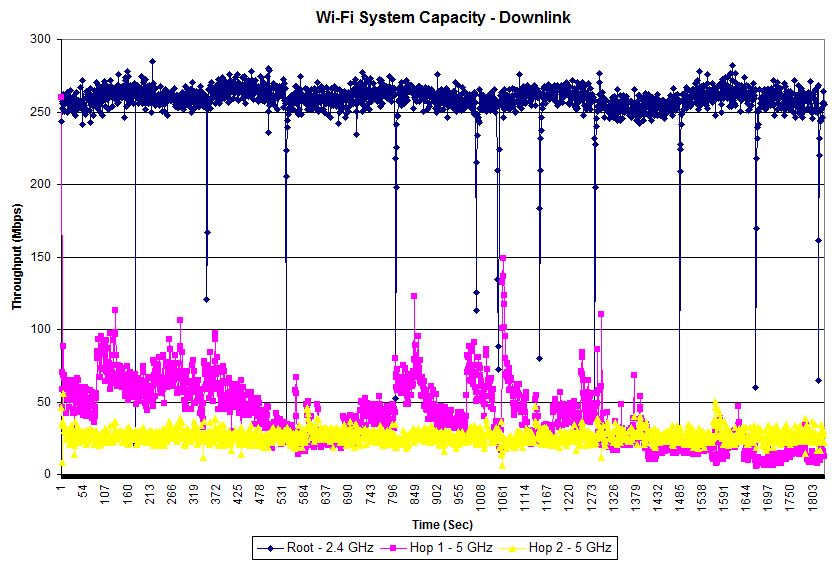
Wi-Fi System Capacity vs. time – Linksys Velop – Downlink
The Velop uplink plot shows higher throughput Hop 1 and 2. But Hop 1 still has the highest variation.
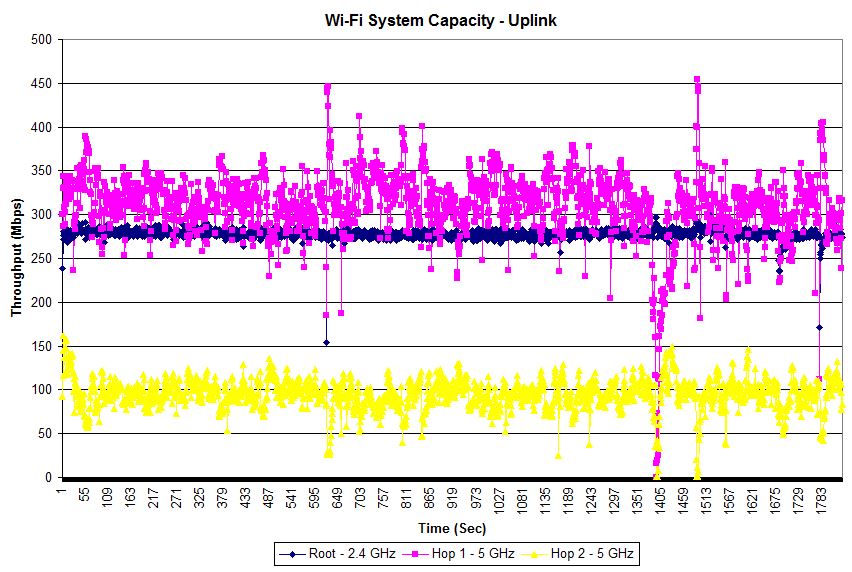
Wi-Fi System Capacity vs. time – Linksys Velop – Uplink
The Orbi downlink plot reflects the relatively similar throughput for the three clients shown in the downlink bar plot above.
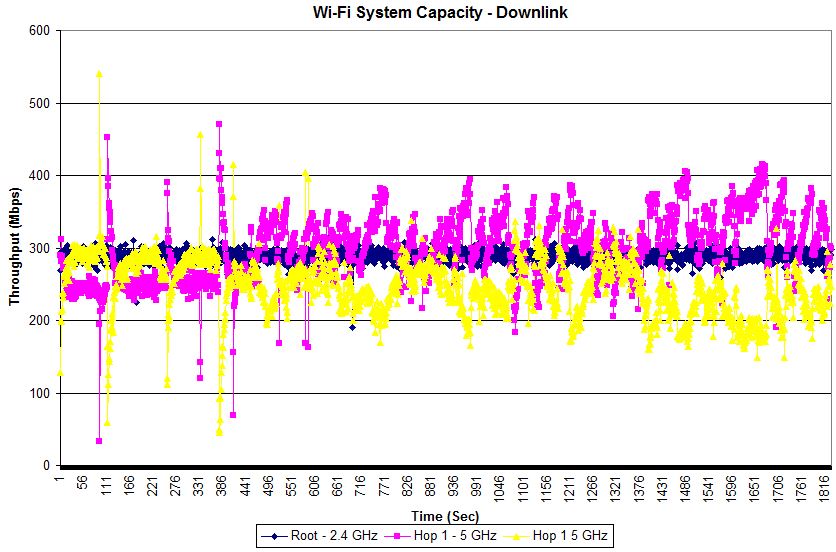
Wi-Fi System Capacity vs. time – NETGEAR Orbi – Downlink
The Orbi uplink plot show the "Hop 1"/Case B 5 GHz client throughput higher than the second 5 GHz throughput shown by the Case C bar above.
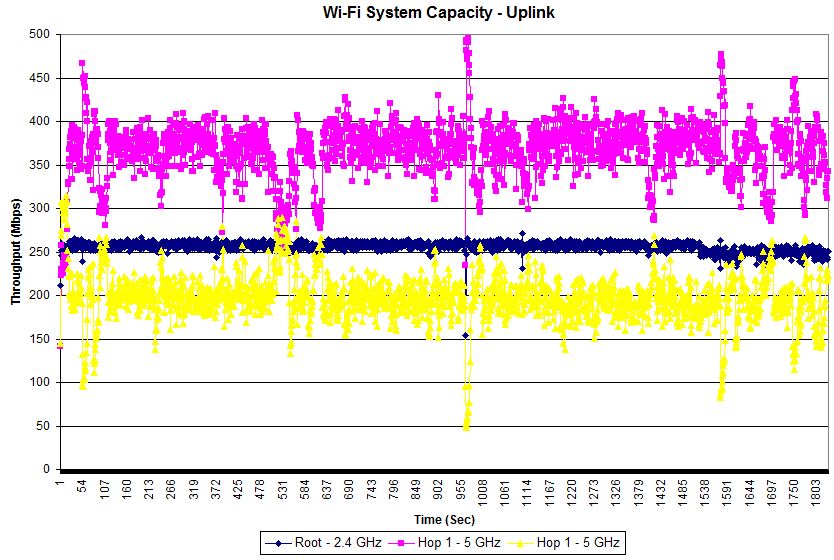
Wi-Fi System Capacity vs. time – NETGEAR Orbi – Uplink
Closing Thoughts
The point of all the plots and data is to back up what was shown up front by the Wi-Fi System Ranker results; the original Orbi has earned its spot as the #1 Ranked Wi-Fi System for Performance.![]() However, I also have to give kudos to Linksys for the second place showing for its Velop system. Whatever problems there were in backhaul management that I found in the original review appear to have been fixed. Now all Linksys needs to fix is Velop’s price, which at $500 is $100 more than Orbi’s $400 list and $150 more than Amazon’s current price.
However, I also have to give kudos to Linksys for the second place showing for its Velop system. Whatever problems there were in backhaul management that I found in the original review appear to have been fixed. Now all Linksys needs to fix is Velop’s price, which at $500 is $100 more than Orbi’s $400 list and $150 more than Amazon’s current price.
